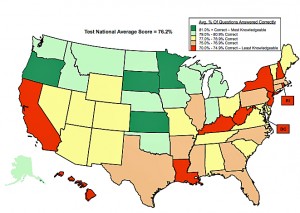Nearly one in five licensed drivers – or about 38 million Americans – would not pass a written drivers test if taken today, according to a new survey from GMAC Insurance.
Some might question why it isn’t more.
The sixth annual survey polled 5,202 licensed Americans from 50 states and the District of Columbia, gauging driver knowledge by administering 20 questions taken from state Department of Motor Vehicles (DMV) exams. Additional questions explored distracting habits such as texting while driving.
Overall, findings indicate a number of licensed Americans continue to lack knowledge of basic rules of the road. The national average score decreased to 76.2% from 76.6 % in 2009. Eighty-five percent could not identify the correct action to take when approaching a steady yellow traffic light and many remained confused by safe following distances.
Kansas drivers ranked first in the nation (82.3% average score); New York drivers ranked last (70% average score). Full results can be found at www.gmacinsurance.com.
“It’s discouraging to see that overall average test scores are lower than last year,” said Wade Bontrager, senior vice president, GMAC Insurance. “American drivers need to make safety a top priority and be aware of the rules of the road at all times. The National Drivers Test allows everyone to brush up on their driving knowledge with a brief refresher course.”
When analyzed regionally, the results reveal that drivers in the Northeast may not be as road-rule informed as their Midwestern counterparts. The Northeast had the lowest average test scores (74.9%) and had the highest failure rate (25.1 percent). The Midwest region had the highest average test scores (77.5%) and the lowest failure rates (11.9%).
Results also indicate that the older the driver, the higher the score. Males over 45 earned the highest average test score. Males also out-performed females overall in terms of average score (78.1% male versus 74.4% female) and failure rates (24 % female versus 18.1% male).
Additional questions from the survey reveal drivers conduct a variety of distracting behaviors behind the wheel; approximately one in four participants admitted to driving while talking on a cell phone, eating and adjusting the radio or selecting songs on an iPod. However, only 5% reported they text while driving.
Overall, a significantly higher percentage of females than males reported engaging in the following distracting situations: conversation with passengers, selecting songs on an iPod or CD/adjusting the radio, talking on a cell phone, eating, applying make-up and reading.



… based on what I’ve seen lately, I bet the percentage of unfit drivers in the metro Detroit area is a lot higher than that!
Written tests have nothing to do with driving competence. Knowing how many feet to park from a color marked curb doesn’t tell anyone whether you’re smart enough to drive without gossiping about your week on a cell phone.
The average American actually drives pretty well on side streets. The two things people need to learn are about freeway driving: 1) Stop having ‘girls gossip night’ via cell phone while driving and 2) YIELD RIGHT FOR FASTER TRAFFIC.
I live in New York State and occasionally go into the city. Let me tell you first hand that these people are stressed out, under pressure and in need of serious help (maybe for good reason). However, it is absolutely no excuse for unsafe driving. We need a major crack-down on this situation.
To steve – that “Written tests have nothing to do with driving competence. Knowing how many feet to park from a color marked curb doesn’t tell anyone whether you’re smart enough to drive without gossiping about your week on a cell phone.” is in itself an indication of the problem, Knowing the rules is part of the responsibility of the driver, to say that written tests have nothing to do with driving competence is a fallacy – the rules are made for a reason, and if you do not know them, stay off my roads.